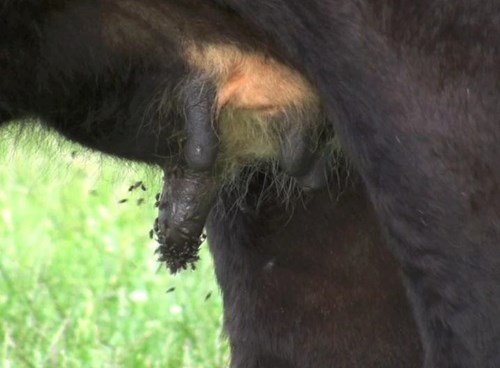Summer Mastitis: Recognising and Reducing Risk in High-Fly Season

The risk period for this acute seasonal disease is now upon us with the highest prevalence between July to September when fly numbers are at their peak. Farmers should now be on the lookout for flies and be vigilant.
Summer mastitis describes a painful aggressive infection of the udder with a bacterial species called trueperella pyogenes the most common cause. Dry dairy cattle, maiden/in calf heifers and weaned suckler cows represent the majority of cases but suckler cows with calves at foot and youngstock of both sexes can also be affected. Animals with larger teats and or previous udder injuries or scarring are considered to be at increased risk.
The nuisance sheep head fly (hydrotoea irritans) is implicated in the spread of the causal bacteria hence the increased risk when there is a significant fly population. These flies live in bushes and trees, and can only fly during mild, damp humid conditions and low wind speeds thus cases tend to be associated with ‘problem fields’ next to woods and high hedges.
In the risk period it is important that susceptible animals are regularly inspected as the severity of infection can rapidly develop, prompt detection and treatment is key. During the early stages of the disease look out for a gradual enlargement, both in length and diameter of the teat(s) of the affected quarter(s) which can be seen for up to one week before the heifer/cow becomes sick. Hindlimb swelling and general stiffness are also reported and without prompt intervention abortion or death can result.


Figures 1 and 2: A heifer with signs of teat and quarter swelling - early signs of disease.
Recovered animals invariably lose the functional use of the quarter. Severely affected animals may show a post recovery of the gangrenous gland. In less severe cases, the first indication of a problem may be the gland is found to be nonfunctional post-calving. A typical observation of such cases shows the teat to have a hard central core of fibrous scar tissue due to the infection which may result in ‘blind quarters’ in heifers. Occasionally, the udder may completely slough off in a similar way to gangrenous mastitis.
Clinical signs:
- A swollen, hot, painful quarter
- Thick, smelly yellow or brown discharge
- Lameness or reluctance to walk
- Signs of fever or dullness, animals away from group
Prevention
Fly control:
- Prevention is better than cure. To minimise the risk of summer mastitis affecting your herd it is important to; Consider which fields are likely to have higher fly populations. Flies like damp/humid areas that have shelter against the wind. The fly species associated with summer mastitis breed in pasture soil and in dung on pasture. The fly's eggs over-winter in sandy soils and emerge in June or July. There is only one generation of adult flies active in July, August and September. High winds and heavy rains inhibit fly activity.
- Implement a fly control programme. Insecticide impregnated ear tags and tail bands mainly containing pyrethroids, together with pyrethroid pour-on, spot-on and spray preparations, are widely used to reduce fly annoyance in cattle. Please speak to your vet to see if any of these products are appropriate for your farm situation.
- Consider providing garlic through mineral supplements to help repel flies.
- If animals have access to housing various types of screens and electrocution traps for buildings are available to reduce fly nuisance.
- There are parasitic wasps that only eat nuisance flies. These are very small insects, approximately 2mm in length and can be sourced online. These can be used to take a proactive, cost-effective approach that reduces the use of antibiotics and insecticides. This is a long-term approach to reducing your overall fly population and should be used in conjunction with other more traditional methods of fly control for the first few years.
Treatment:
Prompt detection and treatment is key. Consult your vet for the best treatment options. Your vet will likely prescribe antibiotics and anti-inflammatories. Anti-inflammatories are necessary to reduce swelling and reduce the cow’s temperature therefore alleviating discomfort. Antibiotics are equally important, to fight the infection.
Stripping out the contents of the udder is of benefit. Think of mastitis as if dealing with an abscess. It’s important to remove as much as possible of the infected material by stripping out the infected quarter as often as is practical. If you so strip out the quarter, ensure the strippings are safely disposed of so they are not available as a source of infection which could be spread to other animals.
Key Take Home Messages
- July to September is highest risk period.
- Prompt recognition is key followed by prompt intervention/treatment.
- Take special care of animals that have teat lesions or wounds to the udder.
- Implement a fly control programme.
- Avoid grazing fields with large fly populations – fields with tree cover and water.
Kythe MacKenzie, Veterinary Investigation Officer, Kythe.MacKenzie@sruc.ac.uk

Unearthed is the exclusive SAC Consulting members' monthly newsletter. Unearthed offers insights and tips from our experts on what we think is in store for farming and crofting in the coming months in order to protect and enhance your business.
Posted by Unearthed News on 16/07/2025
